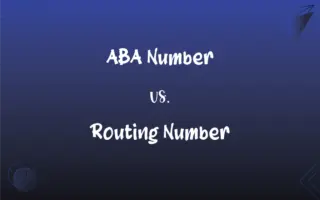Spoken Language vs. Written Language: What's the Difference?
Edited by Aimie Carlson || By Janet White || Published on June 15, 2024
Spoken language is the use of words for communication through speech, often informal. Written language involves constructing words on a medium, typically formal and structured.

Key Differences
Spoken language and written language are two primary modes of human communication, each with distinct characteristics and uses. Spoken language is characterized by its use in verbal communication, where words are articulated through speech. Written language, in contrast, is communication through the written word, utilizing a structured combination of letters and symbols to convey messages. It tends to be more formal and deliberate, with a greater emphasis on grammar, punctuation, and style.
One of the key differences between spoken and written language is the level of permanence and reach. Spoken language is transient, existing in the moment of speech and then fading, though it can be recorded. Written language, however, has a lasting presence, capable of being preserved and disseminated across time and space. This permanence allows written language to serve as a record of knowledge, culture, and personal expression, accessible to future generations.
The informality of spoken language often incorporates colloquialisms, slang, and a more relaxed grammatical structure, reflecting the conversational context in which it is used. This informality facilitates a personal connection and immediacy between speakers. Written language, by necessity, relies on a shared understanding of the written word, punctuation, and structure to effectively convey the intended message without the benefit of vocal cues or immediate interaction.
Despite these differences, both spoken and written language are essential for effective communication, each serving distinct roles in personal expression, education, and the preservation of information. The choice between spoken and written language depends on the context, purpose, and audience of the communication, with each form offering unique advantages and challenges.
Comparison Chart
Formality
Often informal, flexible
More formal, structured
ADVERTISEMENT
Feedback
Immediate, interactive
Delayed, non-interactive
Permanence
Transient, ephemeral
Permanent, lasting
Structure and Grammar
Looser, may include colloquialisms
Stricter, follows grammatical rules closely
Communication Cues
Uses tone, pause, intonation
Relies on punctuation, layout
Revision
Not possible post-delivery
Possible before finalizing
ADVERTISEMENT
Accessibility
Requires presence or technology to capture
Accessible across time and space
Medium
Sound, speech
Text, print or digital
Context
Casual conversations to formal speeches
From personal letters to formal documents
Expression of Emotion
Conveyed through voice modulation, facial expressions
Conveyed through word choice, punctuation
Spoken Language and Written Language Definitions
Spoken Language
Use of voice for communication.
They chatted all night.
Written Language
Communication through text.
He read the instructions carefully.
Spoken Language
Language expressed through speech.
She said hello.
Written Language
Recorded form of language.
The book was published last year.
Spoken Language
Verbal communication using sounds.
Can you hear me?
Written Language
Use of symbols for communication.
The contract was signed.
Spoken Language
Oral form of language.
He spoke passionately.
Written Language
Formalized expression in text.
Her essay won the competition.
Spoken Language
Speech-based interaction.
She whispered the secret.
Written Language
Language that is written down.
The letter was long and detailed.
FAQs
What distinguishes spoken from written language?
Spoken language is verbal and often informal, while written language is recorded and typically more formal.
Why is feedback quicker in spoken language?
Because of the immediate presence and reactions of the audience.
Is spoken language more common than written?
In daily communication, yes, but written language dominates formal and documented exchanges.
Why is written language considered more permanent?
It leaves a tangible record that can be revisited.
Do all cultures have both spoken and written forms of language?
Most do, but some languages are only spoken or only recently developed writing systems.
Can written language convey tone?
Indirectly, through word choice and punctuation.
How does social media affect these distinctions?
It blurs the lines, incorporating characteristics of both forms.
Can the same person use both forms differently?
Absolutely, often varying their use based on context and audience.
Can written language be informal?
Yes, especially in personal communications like texts or emails.
How do gestures fit into spoken language?
They enhance meaning and emotion but are not a substitute for verbal content.
Are emojis part of written language?
Yes, as a modern means to convey emotions and expressions.
Is it easier to learn spoken or written language first?
Typically, spoken language comes first, especially in childhood development.
Is reading a form of spoken language?
No, it's engaging with written language, even if done aloud.
How do misunderstandings differ between the two?
Spoken misunderstandings can often be immediately clarified, while written ones may persist until addressed.
Is spelling important in spoken language?
No, but pronunciation is crucial.
How has technology impacted spoken language?
It's expanded its reach through recording and broadcasting.
Why do some prefer written communication?
It allows time to think, edit, and refine messages.
Can written language capture dialects accurately?
To some extent, through phonetic spelling and descriptions, but nuances may be lost.
What role does written language play in education?
It's crucial for documentation, instruction, and assessment.
How do sign languages fit into this comparison?
They are more akin to spoken language, using visual-spatial means to convey meaning.
About Author
Written by
Janet WhiteJanet White has been an esteemed writer and blogger for Difference Wiki. Holding a Master's degree in Science and Medical Journalism from the prestigious Boston University, she has consistently demonstrated her expertise and passion for her field. When she's not immersed in her work, Janet relishes her time exercising, delving into a good book, and cherishing moments with friends and family.
Edited by
Aimie CarlsonAimie Carlson, holding a master's degree in English literature, is a fervent English language enthusiast. She lends her writing talents to Difference Wiki, a prominent website that specializes in comparisons, offering readers insightful analyses that both captivate and inform.
































































